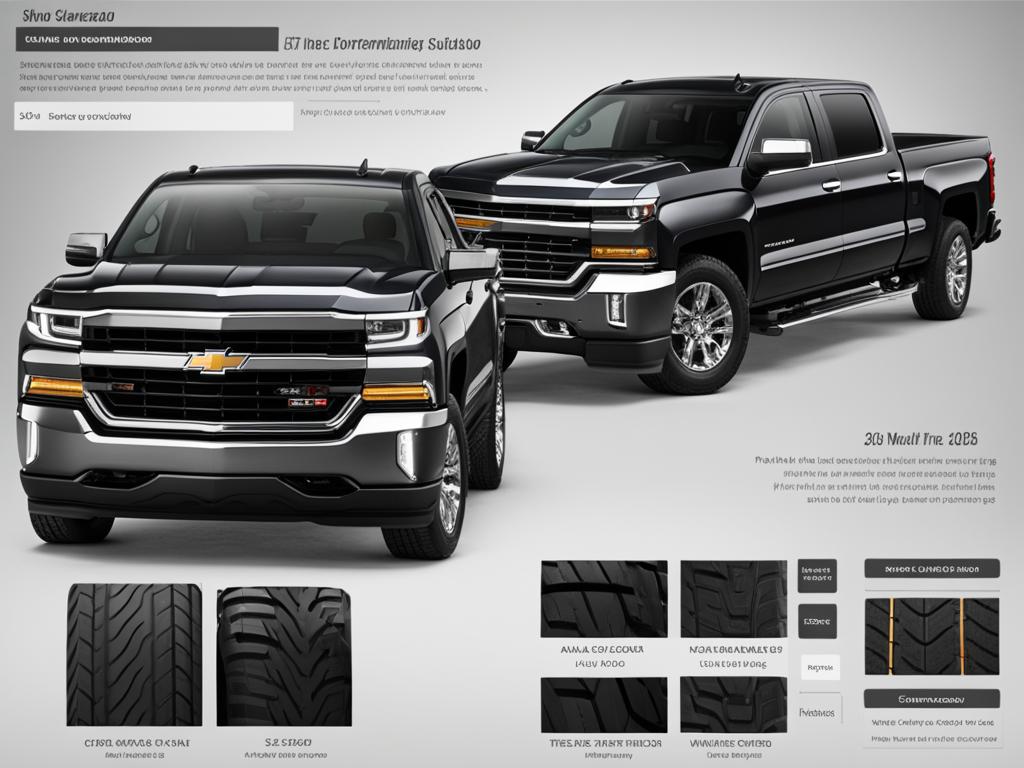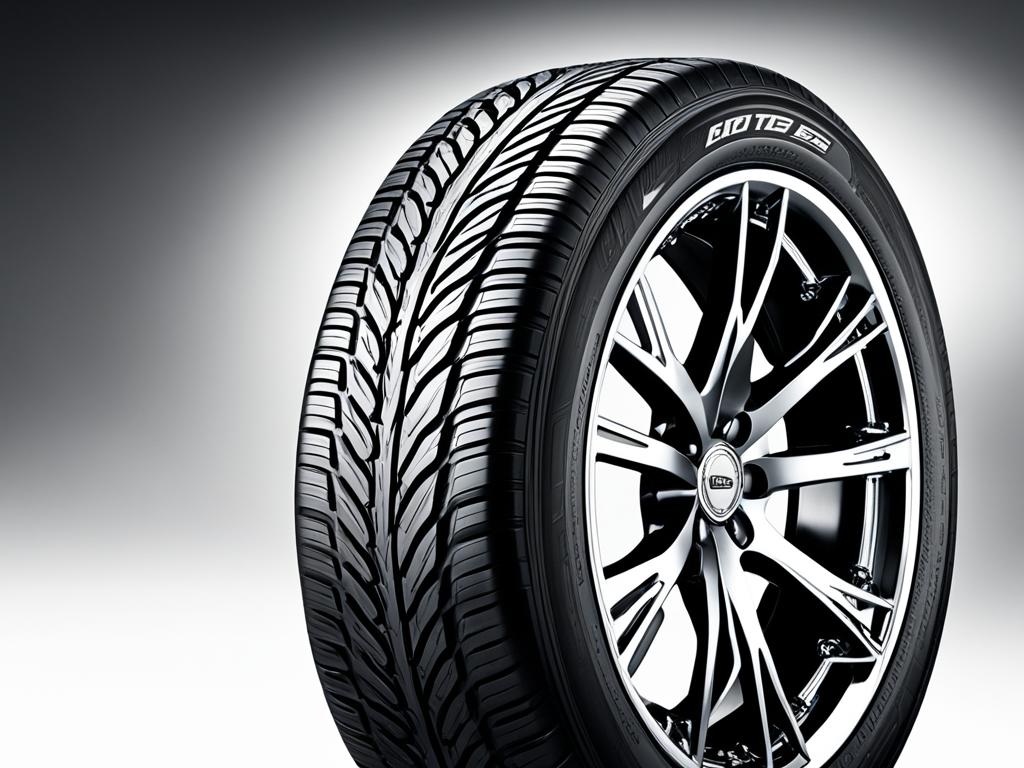Welcome to our comprehensive guide on tire wear patterns and how a tire wear chart can help you identify and diagnose issues with your tires. Understanding tire wear is essential for ensuring your safety on the road, extending the life of your tires, and avoiding expensive replacements. By tracking tire wear patterns and following a tire wear chart, you can proactively address potential problems before they become major concerns.
In this article, we will decipher common tire wear patterns and their causes, explore the significance of tire tread depth, delve into the effects of misalignment on tire life and vehicle safety, discuss proactive tire maintenance practices, highlight the importance of a tire wear chart in diagnosing vehicle issues, and provide critical tips for preventing premature tire wear. Let’s dive in!
Key Takeaways:
- A tire wear chart is a valuable tool for identifying and diagnosing issues with your tires.
- Understanding tire wear patterns can help you ensure safety, extend tire life, and avoid costly replacements.
- Tire tread depth is crucial for legal compliance and safe driving.
- Misalignment can significantly impact tire life and compromise vehicle safety.
- Regular tire inspections, proper inflation, tire rotation, and defensive driving practices can all contribute to optimal tire wear.
Deciphering Tire Wear Patterns and Their Causes
Table of Contents
ToggleUnderstanding tire wear patterns is essential for maintaining optimal tire performance and ensuring your safety on the road. By closely examining the wear patterns on your tires, you can identify underlying issues and take appropriate measures to address them. In this section, we will explore common tire wear patterns and their causes.
Inner or Outer Shoulder Wear - Signs of Misalignment
When you notice excessive wear on the inner or outer edges of your tires, it often indicates a misalignment issue. Misalignment can occur due to various factors, such as hitting potholes or curbs, worn suspension components, or poor installation. It’s essential to address misalignment promptly to prevent further tire damage and ensure a smooth and safe ride.
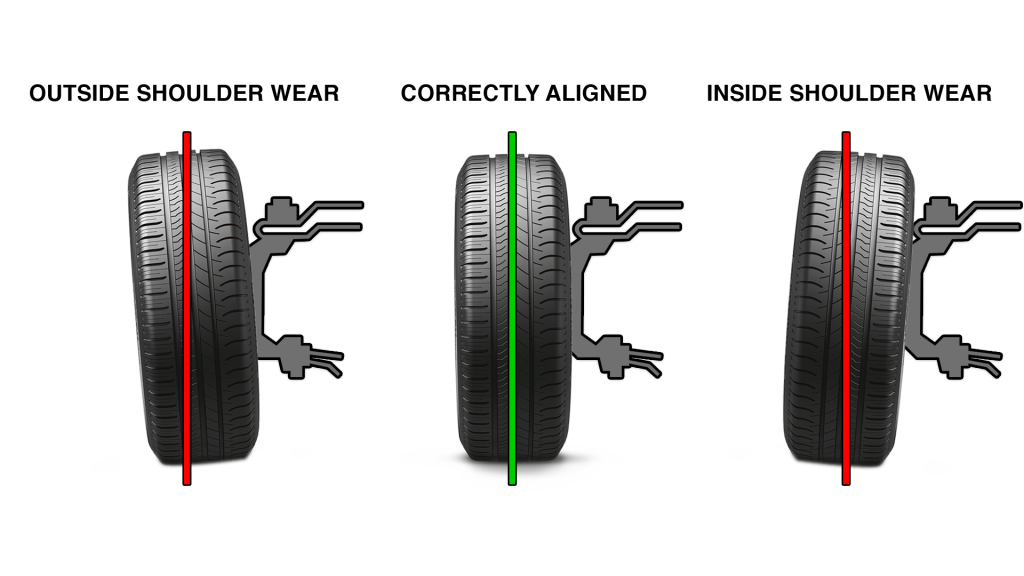
Center Tread Wear - A Symptom of Overinflation
If the center portion of your tire’s tread wears down faster than the edges, it may suggest overinflation. Overinflated tires have reduced contact with the road surface, causing the middle of the tread to bear the majority of the load. This can lead to decreased traction, uneven tire wear, and a harsher ride. Ensuring proper tire inflation based on the manufacturer’s recommendations is crucial for maintaining tire longevity and optimal performance.
Learn more about tire size calculator
Edge Shoulder Wear - Indicating Underinflation
Underinflation is a common issue that can be identified by excessive wear on the outer edges of the tire’s shoulder. When a tire is underinflated, the outer edges bear more of the vehicle’s weight, causing them to wear out faster. Additionally, underinflated tires generate more heat, which can lead to tire failure and compromised safety. Regularly checking and maintaining proper tire pressure is vital to prevent underinflation and its associated wear patterns.
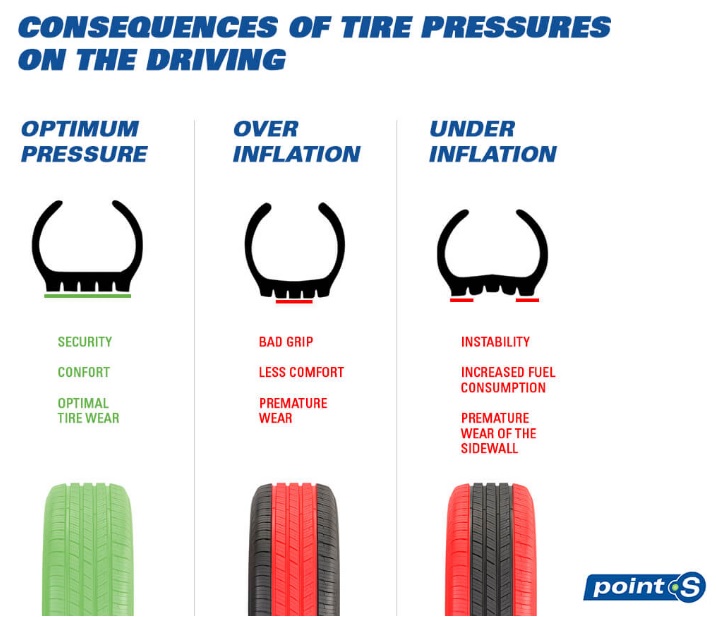
Cupping Wear Pattern - Uncovering Suspension Troubles
Cupping wear pattern appears as scalloped dips or cups on the tire’s surface. It is typically caused by suspension problems, such as worn-out shocks or struts. When the suspension fails to absorb road vibrations adequately, the tire bounces, resulting in uneven wear. Ignoring cupping wear pattern can exacerbate suspension issues and compromise overall vehicle stability and handling. If you notice cupping wear, it is crucial to have your suspension system inspected and repaired by a qualified mechanic.
Learn more about Tire tread depth chart
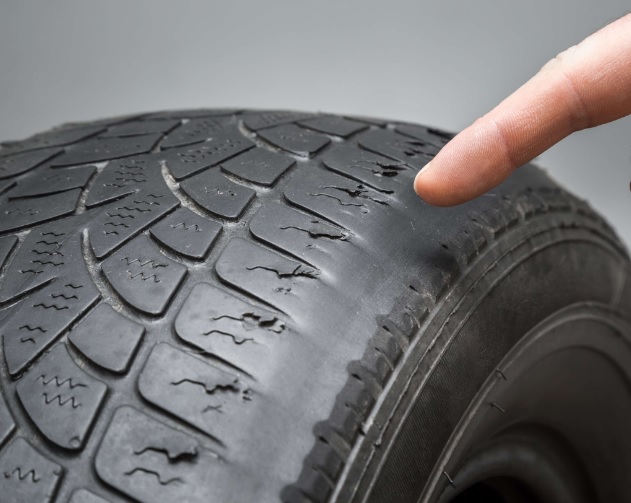
Diagonal and Patchy Wear - When It's Time for Tire Rotation
Diagonal and patchy wear patterns often indicate that it’s time for tire rotation. Tire rotation involves moving the tires to different positions on the vehicle to ensure more even wear. Diagonal wear appears as patterns that form across the tire’s tread in a diagonal manner, while patchy wear is characterized by irregular wear spots scattered throughout the tread. By regularly rotating your tires, you can extend their lifespan and maintain consistent performance.
Understanding the Significance of Tire Tread Depth
Tire tread depth is a critical factor that directly impacts your safety on the road. It refers to the measurement of the space between the top of the tire tread and the deepest groove. In this section, we will explore the legal requirements and safety implications associated with tire tread depth. We will also discuss different measuring techniques, such as the penny test and wear indicators, to determine the condition of your tires.

The Legal Requirements and Safety Implications
Ensuring adequate tire tread depth is not only a matter of compliance with legal requirements but also a crucial aspect of maintaining optimal safety while driving. The tread on your tires plays a vital role in providing traction and grip on the road, especially in wet or slippery conditions.
The legal requirements for minimum tire tread depth may vary by jurisdiction. However, it is generally recommended to have a minimum tread depth of 2/32 of an inch (1.6 millimeters) to ensure safe operation of your vehicle. Driving with worn-out tires that have insufficient tread depth can increase the risk of hydroplaning, reduced control, and longer braking distances, compromising your safety and the safety of others on the road.
Learn more about Tire air cap guide
Measuring Techniques: Penny Test and Wear Indicators
There are several simple methods to measure tire tread depth, allowing you to assess the condition of your tires and determine if they meet the legal requirements. Two commonly used techniques are the penny test and the use of wear indicators.
The penny test involves inserting a penny into the tread grooves with Lincoln’s head facing downward. If you can see the top of Lincoln’s head, it is an indication that your tire tread depth is less than 2/32 of an inch and you should consider replacing your tires. On the other hand, if the top of Lincoln’s head is not visible, it suggests that your tread depth meets the minimum requirement.

Wear indicators, also known as tread wear bars, are built into the tire and are visible when the tire tread depth reaches a certain point. These indicators appear as small rubber bridges across the grooves. If the tread has worn down to the level of the wear indicators, it indicates that your tire is no longer safe and should be replaced.
Using these measuring techniques can help you assess the condition of your tire tread depth and determine if it meets the legal requirements for safe driving. Regularly checking your tire tread depth and replacing worn-out tires can significantly improve your safety on the road and ensure optimal performance.
How Misalignment Affects Tire Life and Vehicle Safety
Misalignment can have detrimental effects on both tire life and vehicle safety. It is important to understand how misalignment impacts your tires and take necessary measures to correct it.
Misaligned tires can cause uneven wear patterns, leading to premature tire deterioration. When your tires are not properly aligned, certain parts of the tires bear more weight than others, resulting in misalignment-related tire wear.

The consequences of misalignment extend beyond tire wear. When tires are misaligned, they can compromise vehicle handling and stability, increasing the risk of accidents. Misaligned tires may lead to decreased traction and steering control, especially during turns or in wet conditions.
To ensure tire longevity and optimal vehicle safety, regular alignment checks and adjustments are crucial. By aligning your tires correctly, you can prevent uneven wear, extend tire life, and promote better handling and stability.
Proactive Tire Maintenance for Longevity
In order to maximize the lifespan of your tires and ensure optimal performance, proactive tire maintenance is essential. By implementing regular tire inspections, maintaining proper inflation, and practicing defensive driving, you can minimize tire wear and extend the longevity of your tires.
Regular Tire Inspections and When to Seek Professional Help
Regular tire inspections are a crucial part of proactive maintenance. Take the time to visually examine your tires for any signs of damage, such as cuts, bulges, or uneven wear patterns. Additionally, check the tire tread depth regularly to ensure it meets the legal requirements and will provide adequate traction on the road.
If you notice any unusual wear patterns, it’s important to seek professional help. An experienced technician can diagnose the underlying issues and recommend the appropriate solutions. They can also perform tire rotations and alignments, further optimizing tire wear and vehicle safety.
Proper Inflation: How to Maintain Optimal Tire Pressure
Proper tire inflation is crucial for maintaining optimal tire pressure. Underinflated tires can cause excessive wear on the outer edges, while overinflated tires can lead to center tread wear. To ensure proper inflation, refer to your vehicle’s manufacturer guidelines or consult a tire professional for specific recommendations.
Regularly check the tire pressure with a reliable gauge and make adjustments as needed. Remember to also inspect the valve stems and caps for any leaks or damage that may affect tire pressure. Keeping your tires properly inflated will not only extend their lifespan but also improve fuel efficiency and vehicle handling.
Defensive Driving Practices to Minimize Tire Wear
Practicing defensive driving can greatly minimize tire wear and ensure your safety on the road. By maintaining a safe distance from other vehicles, avoiding abrupt accelerations and braking, and navigating potholes and road hazards cautiously, you can prevent unnecessary stress and damage to your tires.
Additionally, be mindful of your driving speed, especially when going over speed bumps or uneven terrain. Slow down to minimize the impact and reduce the risk of tire damage. Implementing these defensive driving practices will not only protect your tires but also contribute to overall road safety.
By following these proactive tire maintenance tips, you can ensure the longevity of your tires and enjoy a smooth and safe driving experience. Remember to conduct regular inspections, seek professional help when needed, maintain proper inflation, and practice defensive driving. By taking these proactive measures, you can minimize tire wear and maximize the lifespan of your tires, ultimately saving you time and money in the long run.
Learn more about How to check tire manufacturing date
Tire Wear Chart: How It Can Help Diagnose Vehicle Issues
A tire wear chart is a valuable tool for car owners to diagnose and address potential issues with their vehicles. By closely monitoring the wear patterns on their tires and comparing them to a tire wear chart, you can identify specific indications and causes of tire wear, leading to timely repairs and maintenance.
Through the use of a tire wear chart, car owners can gain valuable insights into the condition of their tires and underlying vehicle issues. The chart provides a visual representation of various tire wear patterns, allowing you to identify specific signs of misalignment, overinflation, underinflation, suspension troubles, and the need for tire rotation.
By cross-referencing your tire wear with the corresponding patterns on the tire wear chart, you can pinpoint the root causes of the wear and take appropriate action. Whether it’s seeking professional help for alignment adjustments, adjusting tire pressure, or scheduling a tire rotation, utilizing a tire wear chart empowers you to effectively address vehicle issues before they escalate.
Regularly referring to a tire wear chart can help you prolong the life of your tires, optimize vehicle performance, and ensure your safety on the road. It’s a proactive approach that enables you to detect and resolve potential problems early on, preventing costly tire replacements and avoiding hazardous situations caused by tire wear.
| Tire Wear Pattern | Cause |
|---|---|
| Inner or Outer Shoulder Wear | Signs of Misalignment |
| Center Tread Wear | A Symptom of Overinflation |
| Edge Shoulder Wear | Indicating Underinflation |
| Cupping Wear Pattern | Uncovering Suspension Troubles |
| Diagonal and Patchy Wear | When It’s Time for Tire Rotation |
Referencing the tire wear chart provides you with an effective tool for diagnosing vehicle issues based on tire wear patterns. By understanding the causes behind various wear patterns and taking appropriate action, you can ensure the longevity of your tires and maintain the safety and performance of your vehicle.
Critical Tips for Preventing Premature Tire Wear
Taking proactive measures to prevent premature tire wear is essential for maintaining the longevity and performance of your tires. By following these critical tips, you can ensure that your tires stay in optimal condition and avoid unnecessary expenses.
Avoiding Potholes and Curb Checks
Potholes and curb checks can significantly damage your tires, leading to premature wear and potential blowouts. To prevent this, always remain vigilant while driving and try to avoid potholes whenever possible. If you cannot avoid a pothole, slow down and drive over it cautiously, taking care not to hit it at high speeds or with excessive force. Additionally, be mindful of curbs and avoid scraping or hitting them when parking or maneuvering.

Understanding the Impact of Aggressive Driving on Tires
Aggressive driving habits, such as sudden acceleration, hard braking, and taking sharp turns at high speeds, can significantly accelerate tire wear. These actions put excessive stress on your tires, causing them to wear out prematurely. To prevent this, adopt a defensive driving approach, maintaining smooth acceleration and deceleration, avoiding sudden maneuvers, and adhering to speed limits. By driving responsibly, you can minimize the impact of aggressive driving on your tires and extend their lifespan.
The Importance of Regular Tire Rotation and Balancing
Regular tire rotation and balancing play a crucial role in ensuring even wear distribution and maximizing tire life. Over time, the front tires tend to wear differently from the rear tires due to variations in weight distribution and the effects of steering and braking. By following the manufacturer’s suggested tire rotation schedule, you can promote uniform wear and prolong the life of your tires. Additionally, regular tire balancing ensures that the weight is evenly distributed across all tires, reducing vibration and preventing premature wear caused by imbalance.
By following these critical tips, you can prevent premature tire wear, optimize the lifespan of your tires, and ensure a safe and comfortable driving experience.
Conclusion
In conclusion, the tire wear chart guide provided in this article serves as an essential tool for tire maintenance and longevity. By understanding and identifying tire wear patterns, you can diagnose potential vehicle issues early on, ensuring your safety and avoiding expensive repairs.
Regular tire inspections are crucial to maintaining optimal tire performance. By visually inspecting your tires and referring to the tire wear chart, you can spot signs of misalignment, overinflation, underinflation, cupping wear patterns, and the need for tire rotation. These proactive measures enable you to address issues promptly and prevent premature tire wear.
Proper tire pressure maintenance is another key aspect to consider. Keeping your tires inflated to the recommended pressure levels not only enhances your vehicle’s fuel efficiency but also contributes to even tire wear. Additionally, following a regular tire rotation and balancing schedule helps distribute the wear evenly, prolonging the life of your tires.
By following the tire wear chart guide, performing regular inspections, maintaining proper tire pressure, and adhering to tire rotation schedules, you can significantly extend the longevity of your tires. Prioritizing tire maintenance ensures your safety on the road while saving you money in the long run. Remember, a well-maintained set of tires is your key to a smooth and enjoyable driving experience.
FAQ
What is a tire wear chart?
A tire wear chart is a visual guide that helps car owners identify different tire wear patterns and their causes. It allows you to analyze the condition of your tires and diagnose potential issues.
Why is it important to understand tire wear patterns?
Understanding tire wear patterns is crucial because they can indicate problems with your vehicle’s alignment, tire pressure, or suspension. By recognizing these patterns, you can address issues early, ensure safety, and extend the lifespan of your tires.
What are some common tire wear patterns and their causes?
Common tire wear patterns include inner or outer shoulder wear (signs of misalignment), center tread wear (symptom of overinflation), edge shoulder wear (indicating underinflation), cupping wear pattern (related to suspension issues), diagonal wear, and patchy wear (suggesting the need for tire rotation).
How does tire tread depth affect safety?
Tire tread depth is essential for maintaining traction and handling on the road. Driving with worn-out tires can significantly increase the risk of accidents, especially in wet or icy conditions.
How can I measure tire tread depth?
There are various techniques to measure tire tread depth. You can use the penny test, where you insert a penny into the tread groove, or look for wear indicators (raised bars) on the tire surface.
What are the effects of misalignment on tire life and vehicle safety?
Misalignment can lead to uneven tire wear, reducing tire lifespan and compromising vehicle handling and stability. It is essential to regularly check and adjust alignment for optimal tire performance and safety.
How can I proactively maintain my tires for longevity?
To ensure tire longevity, frequently inspect your tires for signs of wear and damage, and seek professional help when needed. Maintain proper inflation by regularly checking tire pressure and follow defensive driving practices to minimize tire wear.
How can a tire wear chart help diagnose vehicle issues?
By referring to a tire wear chart, you can match specific wear patterns on your tires with their respective causes. This can help you identify underlying problems and take the necessary steps for maintenance and repairs.
What are some tips for preventing premature tire wear?
Avoiding potholes and curb checks, practicing non-aggressive driving, and adhering to a regular tire rotation and balancing schedule can help prevent premature tire wear and extend their lifespan.


